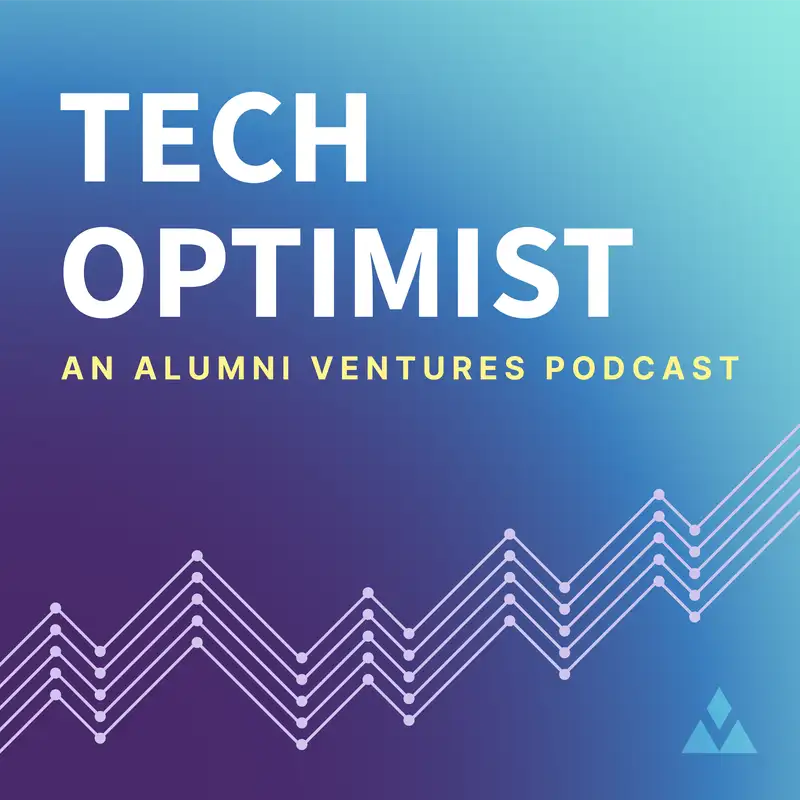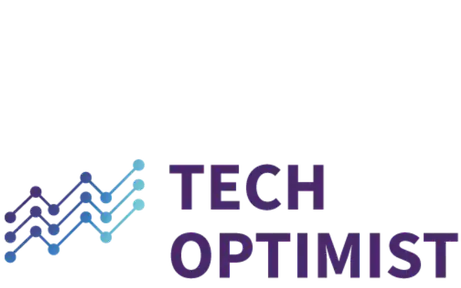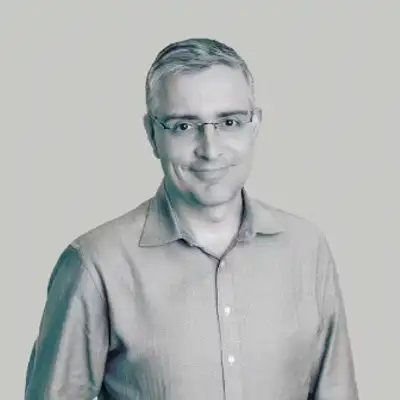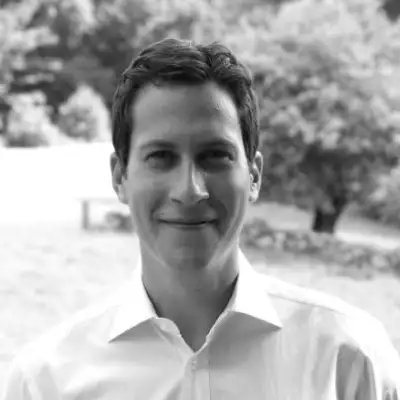#27 - Life-Changing Brain–Computer Interface Technology
Sam:
What if you could control a computer with a piece of Scotch tape on your brain. For people with paralysis and Parkinson's, this is a game changer. My name is Sam, your guide, and welcome back to the Tech Optimist. We're happy to have you.
Michael Mager:
It was really always my goal to build companies. We are developing a brain computer interface. That is an implantable medical device that allows people to control computers with only their thoughts. And that sounds like science fiction.
We are already starting to see things that have never been seen before.
Sam:
In a world captivated by criticism, it's easy to overlook the groundbreaking technologies shaping our future. Let's shine a light on innovators who are propelling us forward.
As the most active venture capital firm in the US, we have an exceptional view of tech's real world impact. Join us as we explore, celebrate, and contribute to the stories of those creating tomorrow. Welcome to the Tech Optimist.
As a reminder, the Tech Optimist podcast is for the informational purposes only. It is not personalized advice, and it is not an offer to buy or sell securities. For additional important details, please see the text description accompanying this episode.
Hello, everyone. Welcome back to this super cool episode of the Tech Optimist. We're going to do things a little bit different today. So today we have a managing partner here at Alumni Ventures, Ludwig Pierre Schulze, who's going to be interviewing Michael Mager, the CEO and co-founder of Precision Neuroscience. This is a really fascinating company, and I can't wait for you guys to hear the conversation between the two.
I did a little dive on this company, just like every company that I do that's featured on the Tech Optimist. And within their website and on some of their social platforms, I found a very well done introductory video to the company, to the big stakeholders into the company, into their technology. And I figured this would be a good way to sort of start this episode off.
So this is a video that Precision Neuroscience had cultivated for just their mission and their values as a company. And I wanted to share it. So here is this, and then right after that, we're going to hop right into the interview with Ludwig.
So enjoy, and I will see you in a few minutes.
Michael Mager:
There are millions of people who have lost the ability to move and to speak as a result of neurological injuries such as stroke, spinal cord injury, and ALS. What would it take to restore their movement? To give them back their voices?
Ben Rapoport:
Precision is about building a new technology that will allow us to interface with the brain in ways that have never before been possible.
Michael Mager:
Brain computer interfaces, or BCIs, create a direct communication pathway between the electrical activity of the brain and a computer.
Ben Rapoport:
The brain is an electrical organ. So when we build a brain computer interface, it harnesses the electrical nature of the brain to communicate with the outside world.
Michael Mager:
We have developed the Layer 7 Cortical Interface, which is the highest bandwidth link between computers and the human brain that's ever been created. This allows people through thought alone to operate a computer, to communicate. This is real. This is not science fiction.
Dr. Peter Konrad:
The first time we placed that array on, and you could just see the electrical activity just washing over the surface of the brain, I thought to myself, gosh, I'm actually watching the brain think.
Farzana Ali:
I was in my junior year, and our car got hit by a drunk driver. I came to learn that I actually suffered a spinal cord injury. Having access to a technology like BCI gives me a hope of living a life that is more independent.
Craig Mermel:
Precision is really poised to bring tremendous hope to millions of people. When we started the company, Ben told us his vision has always been to push this into clinical practice.
Michael Mager:
Ben is the intellectual architect of the system that we're building at Precision. He's a neurosurgeon, so has deep understanding of and respect for the anatomy that we're dealing with, but he also has an engineer's background, both of which are critical to building a BCI system.
Ben Rapoport:
The traditional methods of placing electrodes painted on the brain usually require making a hole in the skull.
Michael Mager:
This is not an appealing prospect for most people. The micro-slit insertion technique was invented by Ben, and that enables us to deploy thousands of electrodes in a way that is minimally invasive.
When we started precision, there was a view that you needed to penetrate the brain in order to build a powerful BCI system.
Dr. Peter Konrad:
Even the smallest BCI electrodes that are out there do destroy some neurons when they're stuck into the brain.
Michael Mager:
And Ben's very firm conviction was that that was wrong.
Ben Rapoport:
The Layer 7 Cortical Interface is embedded in thin film that coats the surface of the brain without penetrating the brain. It is a fraction of the diameter of human hair, and that fundamentally allows us to generate a very high bandwidth interface with the brain without doing any damage, and in a way that could be potentially reversible, and even upgraded.
Craig Mermel:
The standard of care in neurosurgical practice is to use four or eight contacts. The Layer 7 device has 1,024 contacts, so over 250 times the spatial resolution. And that's like comparing a movie taken using hand-cranked recorders and bringing it to a world of 4K.
Dr. Peter Konrad:
You could literally begin to see the words as the patient was speaking them, and form various patterns of electrical activity in the brain.
Michael Mager:
It's an enormous amount of data that's coming off of these arrays, and it's really artificial intelligence driven software that makes sense of it.
Ben Rapoport:
We're using machine learning architectures and artificial intelligence that were inspired by the brain to decode the brain's own language. And in order to build a highly functional communication channel between the brain and artificial intelligence, you need a lot of data.
Craig Mermel:
Already in our first five patients, we started to collect that data. And over the next year, we'll be scaling up that data collection.
Michael Mager:
We're now in the process of ramping up to three sites from one. In just over two years, we went from funding to having a device on the brain of a human patient. Other companies in this space that are 6, 7, 8 years old have yet to do a human implant.
We've been able to move really quickly now that our arrays are manufactured in a facility that is owned and controlled by Precision Neuroscience.
Craig Mermel:
Supply chains themselves can be quite fragile. So having the plant here in the United States gives us the greatest degree of control and confidence.
Stephanie Rider:
This facility is particularly unique because we have a quality system that's specifically related to biomedical devices. We need increased control over this process and increased oversight in order to mitigate any safety concerns for patients.
Mark Hettick:
We're really the only people on earth that can make a device like this.
Craig Mermel:
We've been able to recruit just incredible talent.
Michael Mager:
The team is now 50 people.
Fraser Tan:
I spent six years at Google.
Kyle Reed:
Apple.
Lizzie Widdicombe:
I used to work at the New Yorker.
Morgan LaMarca:
Before Precision, I worked at Neuralink.
Jackie Dister:
Valencia Technologies.
Elton Ho:
Postdoc at Stanford.
Adam Poole:
I used to work at Neuralink.
Michael Mager:
Because our system is reversible, we are able to access the 510(k) pathway, which is the most rapid pathway to clinical approval through the FDA. This gets us into market, generating revenue, and it starts to generate the high resolution neural data repository that's really going to drive our algorithms.
The initial use case for the Precision system will be to restore function for paralyzed people. Beyond that, the two applications that we're very excited about are stroke rehabilitation and refractory depression.
In coming decades, we do see the possibility for this to be more of a general use technology. It's possible that this is a new frontier in how human beings and computers will interact.
Craig Mermel:
Our goal is to help as many people as possible, and we think this technology that we're developing could ultimately have an impact not on tens or hundreds or thousands of patients, but many millions.
Ludwig Pierre Schulze:
Michael, thanks so much for joining us today. Really appreciate you taking the time. We'd like to kick off straight away and jump into a little bit about you. And can you just share a bit of your background, your journey, from studying at Harvard and Cambridge to becoming a pioneer in the brain computer interface field?
Michael Mager:
Yeah. So after I graduated from Harvard, I moved to Asia and joined a hedge fund there called Ward Ferry Management, which is now about a 4 billion hedge fund, investing in companies from India to Australia and everything in between. And that was really my business school. Lots of different industries, countries, companies at different stages of development, and really countries at different stages of development.
But it was really always my goal to build companies. And I left in 2012 after becoming a portfolio manager and partner of the firm. I took a year off, I did a master's degree at Cambridge.
And then I moved back to New York. And really started buying and building companies myself and with a partner. And it was several years into this, after acquiring and growing a number of companies, when I met Ben Rapoport, and that was the genesis of Precision.
Ludwig Pierre Schulze:
Excellent. So maybe in layman's terms, give us an explanation of what your company does and what brain computer interface space is.
Michael Mager:
We are developing a brain computer interface. That is an implantable medical device that allows people to control computers with only their thoughts. And that sounds like science fiction, but it has been done now actually for 20 years. The first person was implanted with a brain computer interface in 2004 named Matt Nagle. And he, though he was a tetraplegic, was able to control a computer mouse with his thought alone.
And over the course of the past 20 years, around 60 people have been implanted with these devices and have been able to do a number of different things, from play video games to send emails and text messages, to create digital art. But all of it has been in the academic setting. So really sort of trapped in academic labs, surrounded by technicians.
And our job at Precision, the mission that we've undertaken, is to take this technology that we know works and has the potential to change the lives of a large number of people, and productize it so that it can scale to millions.
Ludwig Pierre Schulze:
Perfect. So maybe let's dig in on that. Tell us more about that societal impact. Who's going to benefit from BCI as you go out to serve millions of people?
Michael Mager:
So the initial use for Precision's device is people who cannot use their arms or their hands as a result of paralysis. And that paralysis can be caused by an injury like a spinal cord injury, a disease like ALS, or other degenerative diseases.
And really, if you can't move your arms or your hands, you can't operate a computer or a smartphone in the way that you or I can. And in 2024, if you can't operate a computer, it's very hard to have a job. It's very hard to stay in communication with friends and loved ones. It's hard to be connected. And so this fundamentally is the functionality that we are going to deliver to patients.
There are about 400,000 people in the United States who, as a result of spinal cord injury and ALS and other diseases, cannot move their arms and hands, and about 30,000 patients that are new every year. And there are many millions globally. We're focused on the US initially, but long term, we expect and hope that will a global business.
Ludwig Pierre Schulze:
So obviously, you kind of alluded a little bit to it before, but you are touching the soul of the human being with their brain, right? How do you think about the ethical dimensions here? What are the considerations that you need to have?
Michael Mager:
Well, I think right now the efforts are pretty straightforward. We are offering therapy to a group of people who today have nothing. And we're giving them a chance at more independence. And over time, we believe that we'll help people really generate an income for themselves and create self-sustainability. I don't think there's a huge amount of debate around the ethics of that first function.
Over time, the debate will change. And I think it will really change as these systems become more powerful, and it'll depend on what they're used for. So as an example, right now all of our functionality is focused on recording from the motor cortex. So the intended movement for people who, because of an injury or an illness, cannot move, but recording the brain activity that's associated with those movements to operate a computer.
Our system is capable of not just reading neural activity, but also writing. So stimulating the brain. And the way that that ends up getting used I think will likely change the ethical considerations and questions. But it's hard to predict, and I think it'll really be driven based on what we're able to deliver in terms of function and what the systems are used for.
The topic that we spend a lot of time thinking about that's connected to this question is really access. How can we ensure that this life-changing technology is not only attainable by a small group of people, but that it's widely accessible? And that's ultimately a question about insurance coverage. And so we're spending a lot of time today preparing for the discussions with CMS for public insurance and with private insurance companies to ensure that this technology is covered, and that the people who can benefit from it are able to access.
Ludwig Pierre Schulze:
Understood. So let's go back maybe to a little bit of the history of precision. So you all started together in about 2021. Tell us about those early days and the vision that brought that team together to make this happen.
Michael Mager:
Yeah. Precision really was created out of the vision of Ben Rapoport, whom I co-founded the company with in 2020. Ben's vision... To take a step back, Ben is a neurosurgeon. Ben has a PhD in electrical engineering. Ben has spent his whole life preparing to start a BCI company and pioneer this industry. Ben was previously one of the co-founders of Neuralink, which is another company in the space.
And ultimately, Ben's vision has been a very consistent one over the course of the past nearly two decades, which is that a brain computer interface should be high bandwidth, so it should have a large amount of information content that it's able to handle, and it should not damage the brain itself. It should be reversible, and that's really a function of its being non-damaging. And because it's non-damaging, it should be able to be scaled 10 times, a hundred times, even a thousand times from the first few versions without any incremental damage to the brain or really risk to the patient.
Most of our early employees, we now have 65 people across the country, but our initial group of co-founders and early employees, most of them came from Neuralink, where Ben had been a co-founder. They knew Ben. And I think they really understood the potential for this technology long-term, and also the drawbacks of some of the approaches that are being pursued by other companies in the space, which do involve some degree of damage to brain tissue.
Sam:
We'll be right back right after this.
Ludwig Pierre Schulze:
Hi. Just a brief interruption to introduce you to the Healthtech Fund from Alumni Ventures. Alumni Ventures is one of the most active and best performing VCs in the US, and we have raised over a billion dollars from more than 10,000 individual investors.
With our Healthtech Fund, you'll have the opportunity to invest in a portfolio of around 20 HealthTech startups. From transformative healthcare services to groundbreaking diagnostics, our founders are paving the way for a healthier future. To learn more, visit us at av.vc/funds/healthcare.
So I'm curious a little bit more about that relationship with you and Ben and sort of the meeting of the minds there. The synergies of, I guess having gotten to know both of you now over time. It's always interesting to hear the co-founding sort of story. How do you think about all that?
Michael Mager:
Well, Ben and I met through a mutual friend. He and I went to college together but didn't know each other at the time, and someone who was there at the same time as we both were put us in touch, really with the introduction that Ben is brilliant and has an idea that has the potential to be world changing and enormously impactful, but needs help developing a business, raising capital, recruiting a team, developing a corporate culture. Doing all the things that are required to translate an idea into something that has widespread impact.
Ben is a neurosurgeon. Ben is a brilliant engineer and innovator. I am none of those things. But what I have is a skillset-
Ludwig Pierre Schulze:
Come on, Michael. You are brilliant. I mean, at least conclude that part. Maybe not a neurosurgeon.
Michael Mager:
I have a complimentary set of skills that I think has been terrific. He and I really I think respect and trust each other, and allow each other to really operate in the domains where we're expert. And I think that that's from our early days of having a few people around the table to now three offices across the country and we've raised 53 million and we've done 14 human implants. It's been great, and I think we've been able to do that in a short period of time, about three years. And it's really been around focusing on exactly what we want to do, how we want to do it, and what sort of people we need to do it. And then just focusing on execution.
Sam:
As I was doing my Precision Neuroscience research dive here in preparation for this episode of the podcast, I stumbled upon their about page on their website, and it's where they've listed their company milestones. And here, Michael was talking about how in just a span of three years they've done so much. And I wanted to help him out and provide some proof that they have done so much in three years. And I think it's so fascinating and super cool that they have their milestones on their website, so I'm going to share a few.
So in the year 2021, Precision launched. They raised their first capital. They patented the minimally invasive micro-slit technique, which we heard in the video earlier. And they developed and patented the first version of the Layer 7 Cortical Interface.
Now, in 2022, they raised their Series B capital. They doubled the channel entry count of microelectrode arrays. They submitted 17 new patent applications.
And then in 2023, they launched their clinical partnership with West Virginia University with their first human implantation, which was a huge milestone for them. They acquired an integrated Precision Bio-MEMS, a microfabrication facility for medical devices. They had their FDA breakthrough designation.
And most recently in 2024, they've launched clinical partnerships with Penn Medicine and Mount Sinai. So great stuff, and can't wait to hear what else is on the horizon.
Let's get back to the show.
Ludwig Pierre Schulze:
So let's speak a bit about those 14 patients. So can you share some of the insight from those patients, from those examples, and some of the initial successes and outcomes from those patients?
Michael Mager:
Yeah. So we've done 14 implants so far with our system across three different medical centers. West Virginia University, which came online last year was our first site. And earlier this year, Penn Medicine in Philadelphia and Mount Sinai in New York.
We are still in the early days. So we are doing temporary implants. Really validating the safety of the system, the efficacy of the system, our ability to record and decode large amounts of high resolution neural data. And also establishing that we are recording ground truth. That we're seeing the same things as the existing standard of care electrodes which are used in neurosurgery today across the country, but at resolutions that are hundreds of times really what has ever been used in the past.
We are already starting to see things that have never been seen before. So patterns of neural activity preceding and then during motor activity that you can't find in the academic literature. And I've been lucky enough to be in the operating room when our system is implanted on patients, and seeing the reaction from the neurosurgical staff, the interoperative monitoring staff, the nursing staff, for that first time, just this incredibly high resolution data start to populate. It's a really exciting time, but we are in early days of this journey.
Ludwig Pierre Schulze:
Yeah. And so your particular technology, the Layer 7 Cortical Interface, obviously is significant as an innovation in the industry. Can you speak a little bit more to how it's designed and the surgical techniques involved are different than what's available in other BCI solutions?
Michael Mager:
Most of the other brain computer interface systems that are high resolution, i.e. the ones that are able to transmit large amounts of data, are based on paradigms that involve penetrating into the brain. So in one way or another, having electrodes poke holes in the brain that do underlying damage to tissue.
And this has a number of issues associated with it. One is scalability. As I mentioned before, our view is that systems should be able to increase in bandwidth over time, 10, 100, 1000 X. And if you think about other sort of communication devices, and that's really what this is, this is a device that now allows the brain to communicate with external computing power, bandwidth has really been key to unlocking additional use cases. But you've really wanted to architect in such a way that bandwidth could increase massively over time.
A system that is based on incremental bandwidth being achieved by incremental brain damage, we just don't think it can scale in that manner. And so one of the founding convictions of Precision has been that a proper BCI system should be able to scale without doing brain damage. The way that we accomplish that is a ultra-thin film array. So it's basically, think about a piece of Scotch tape, it's got that sort of consistency, that is 20 microns thick, so it's about a fifth of the width of a human hair. And as a result of how thin it is, it conforms to the surface of the brain incredibly well. So it sits on the surface of the brain underneath the skull and underneath the dura, and creates a direct interface with brain tissue without harming or disrupting the underlying tissue that it is in contact with.
And that's how we have... We announced just this week that we broke the world record for the number of electrodes on a human brain at once, of 4,096 in Mount Sinai. And whether there are four electrode arrays on the brain, in this case, that was the case, or one, or 10, you're not doing any incremental damage to the tissue, and you're not posing any incremental risk to the patient.
The other key innovation at Precision has been the way that the electrode arrays are deployed. So traditionally, cortical surface arrays, which is what sort of an array that sits on the surface of the brain is called, they've been much, much lower resolution, 1/200 or 1/300. But also they've required very invasive surgeries to implant really craniotomies, which require taking off large amounts of skull. And this is also the way that the penetrating electrode array-based technologies are deployed as well.
When you think about having this technology scale to millions of patients, craniotomies pose a number of risks. So we really designed around that. The innovation involves a very thin slip that is drilled into the skull and in the dura, so it's about a millimeter in thickness. And the array is able to pass through the slip, sort of like a letter through a letter box. And this doesn't even require a shaving your head in order to have a super high bandwidth brain computer interface implanted.
So I think these are the kind of design considerations that we really spent a lot of time thinking about and focused on.
Ludwig Pierre Schulze:
Perfect. Thank you, Michael. And so what about the regulatory dimensions here? The FDA? Where are you in this process and what are the key next steps there?
Michael Mager:
We expect our first FDA clearance this year. We are able to access the 510(k) pathway, which is the fastest pathway for a medical device company. And it's really available to Precision and no other BCI company because of the underlying safety profile of our device and the fact that it's reversible. This will allow us to implant for up to 30 days. And we expect additional 510(k) clearances for some of the electronics that help power our system next year.
With that, with the array plus the electronics, we have the opportunity to commercialize our technology for the first time. As we work towards the permanent implant, which is subject to a PMA, which is a longer process and will take another four or five years.
The opportunity to get into business next year, not in 10 years, but next year, I think is a huge competitive advantage for precision. First of all, it allows us to start generating revenue to help defray our ongoing R&D costs. It helps establish a relationship with all of the stakeholders who are going to be critical for the eventual rollout of the chronic system, whether it's the neurosurgical staff, the nursing staff, the hospital administrators, the payers, all will be aware of the company. And we're going to help build the distribution network that will be critical for the long-term implant.
And finally, it's data. The amount of data that we're already getting in these first pilot human studies is incredibly important and valuable, and that is just going to increase exponentially with our 510(k).
Sam:
Everyone knows the drill at this point. We'll be right back right after this. Don't go anywhere.
Ludwig Pierre Schulze:
Ever wonder how the ultra wealthy invest their money? They often back startups before they go public through venture capital. Now individual investors like you can too with Alumni Ventures. Visit av.vc to get started.
Perfect. So one of the things I think that sometimes gets glossed over in the startup world is that even the best companies have moments of difficulty or challenges that they have to overcome that sometimes get lost in the story, if you will.
Any examples of that that stick out in the last couple of years that you have all experienced and presumably overcome to be where you are now?
Michael Mager:
Of course. Absolutely. I think one of the most acute challenges we faced was really over the manufacturer of our arrays. So what we've developed at Precision is an array that is microfabricated using the same technology as semiconductor chips. You can't make a thousand-electrode array that has surface area of about one and a half square centimeters by hand. And by hand is still the way most medical devices are manufactured today, which is extraordinary.
There is no domestic supply chain to manufacture arrays at this level of sophistication and at scale. We looked all across the country, and really we found two suppliers that we thought might be able to do it. One was very happy to take our business, but over the course of a year and a half and over $2 million, produced six arrays in total, which had an average yield, so the number of electrodes that actually worked, was about 55%.
The other facility was very professionally able to manufacture our arrays, but owned by a Japanese company, a multinational corporation, that had a blanket ban on developing anything for human implants.
So we knew the system was manufacturable, but we could only use the high resolution, high yield arrays for in vivo work, for animal work. Incredibly frustrating and difficult situation.
I think the Japanese company that owned this facility in Texas had acquired it as part of a larger acquisition. That was sort of a lump. And they told us in the spring of last year that they intended to divest it. Actually, they intended to close it down. We had a call, very apologetic.
Immediately, we jumped at the opportunity and said, "All right. We're going to buy it. We're going to take over your employees and offer them a safe home, and we'll be stewards of this facility going forward."
The whole process from that initial conversation to closing was six weeks. It's just an unbelievably [inaudible 00:32:47] period. And we didn't cut corners. We did all of the legal due diligence, environmental due diligence, facility due diligence that you'd have to do.
We ended up acquiring the facility for what we believe is a 90% discount to replacement cost, potentially more. And we also inherited a team that we knew was capable of manufacturing these arrays because they had done it before. And I'm happy to say that all of the employees are still at the facility and churning out several thousand arrays a year at this point with yield of 99% plus.
So the story has a very happy ending, but it was a critical challenge for the company. And we had a few irons in the fire, and we're lucky that one of them hit and we jumped at the opportunity.
Ludwig Pierre Schulze:
Yeah. Yeah. Definitely turning potentially a very challenging issue into a great outcome, great opportunity for the business. That's excellent.
All right, excellent. Well, let's get to sort of the last bit of this, Michael, which is we have a large community, many of which hopefully joining us today. And we'd love to hear from you what ways in which that community can be useful to you. To you, to precision. What would be of help?
Michael Mager:
Well, we're always looking for additional sites to use for our clinical studies. So far we've been fortunate, and all of the demand has been inbound to use our system. And we're anticipate going from three sites where we're actively implanting to six in the next two or three months. But we want to scale this up both in the research setting and with our 510(k) in the commercial setting.
And we think that this sort of transition into high resolution electrophysiology, even before the BCI functionality, just being able to see the brain during neurosurgical procedures, and its activity in resolutions that have never been seen before. Already we're seeing potential really meaningful clinical benefit. And so we want to get the word out to as many of the top centers in the country as possible.
And I'd say the second major area is talent. As the potential of this industry becomes clear, and also the fact that you're now actually seeing that transition from the academic lab into the clinic after a long period of waiting, the market's starting to heat up. And we require a diverse set of skills internally, from microfabrication and material science to ASIC design and microelectronics to cutting edge machine learning-based software engineers. And the market for that sort of top tier talent is just becoming more competitive.
And so for folks who want to do something that has the potential to both make a really big impact from a human health perspective, a really positive impact in the world, and also be part of something that I think has the potential to be an enormous business, I think it's a great opportunity. But we're always looking for referrals for great people.
And finally, capital, obviously. That's the genesis of our relationship to begin with. We are developing a product that is significantly hardware in its makeup, and it will require more capital for us to go from where we are to get to market.
Ludwig Pierre Schulze:
Perfect. Well, Michael, thank you again so much for joining us today. Really, really appreciate your time. And yeah, good luck with the next steps here.
Michael Mager:
Okay. Thanks, Ludwig. Thanks for your support.
Ludwig Pierre Schulze:
Absolutely.
Sam:
Thanks again for tuning into The Tech Optimist. If you enjoyed this episode, we'd really appreciate it if you'd give us a rating on whichever podcast app you're using, and remember to subscribe to keep up with each episode.
The Tech Optimist welcomes any questions, comments, or segment suggestions, so please email us at info@techoptimist.vc with any of those, and be sure to visit our website at av.vc. As always, keep building.








